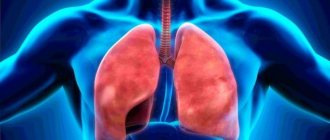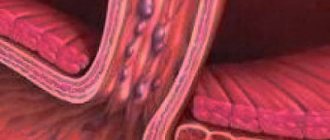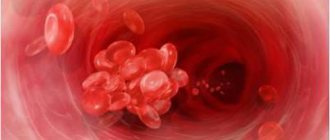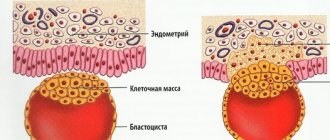From this article you will learn: what is intestinal bleeding. Causes and treatment.
Intestinal bleeding is the release of blood into the lumen of the small or large intestine. Blood is released from the damaged intestinal wall and sooner or later leaves the body naturally during bowel movements. Moreover, the nature of the blood in the stool will be very different depending on either the localization or “height” of the site of damage to the mucous membrane. The higher in the gastrointestinal tract the release of blood begins, the more altered the blood will be in the stool.
It is by the unusual appearance and color of stool that a patient may suspect something is wrong with the intestines.
Management of hemorrhoids is based on clinical presentation and stage of the disease. Hemorrhoids are usually the most effective option. Treatment is specific to the body based on stool examinations. Uremic colitis is now a subject of historical interest. In the predialysis era, autopsy specimens of untreated uremic patients revealed ulcers and pseudomembranes called uremic colitis. Now, due to the widespread availability of hemodialysis, this organism is no longer observed.
Intestinal bleeding is only a symptom or manifestation of a particular disease, some of which are deadly. That is why the slightest suspicion of bleeding from the intestines should be a reason to consult a doctor. The primary link in diagnosis most often becomes a general practitioner, who, as necessary, refers the patient to a surgeon, proctologist, gastroenterologist or oncologist.
Traditional causes, including diverticulosis, should also be considered. There is a high risk of colonic perforation during colonoscopy among hemodialysis patients compared with the general population. Precipitation of beta2-microglobulin has been suggested to play a role in colonic perforation. Colonic perforation has a higher mortality rate in dialysis patients compared to the general population.
The authors declare no conflict of interest. Zuccaro, Management of the adult patient with acute lower gastrointestinal bleeding. American College of Gastroenterology. . Bleeding in the small intestine can have many causes and may cause blood in the stool or anemia in some patients. It often stops for a while and then starts again and can appear anywhere along the 20-foot length of the small intestine. Therefore, finding the source of bleeding from the small intestine is a big problem.
The prognosis of the disease depends entirely on the severity of the bleeding, as well as the immediate cause of this condition. In some cases, the disease can pass without a trace, and sometimes it threatens the patient’s life. In approximately 60-70% of gastrointestinal bleeding, the cause is peptic ulcer of the stomach and duodenum - without immediate help, such conditions can claim the patient’s life in a matter of hours.
What are the most common risks for small bowel bleeding?
Minor intestinal bleeding may be subtle or silent. However, when symptoms occur, they may include. Blood in bowel movements Black, tarry stools Unexplained anemia. . If bleeding is sudden or severe, symptoms may include: Our team of small bowel gastroenterologists has extensive experience with these procedures, and our physicians are among the nation's experts in this field. The most common source of small bowel bleeding is angioectasias, which are abnormal blood vessels that lie within the wall of the small bowel and are most common in older patients.
Causes of intestinal bleeding
The main reasons for the flow of blood from the intestines:
- Peptic ulcer of the stomach and duodenum is the most common cause of the appearance of altered blood in the stool.
- Diseases of the rectum: anal fissure, hemorrhoids.
- Injury to the rectum: The rectum can be injured by a fall or a foreign object. The rest of the gastrointestinal tract can be damaged by foreign objects accidentally or deliberately swallowed by the patient: needles, hairpins, blades, and so on.
- A special group of inflammatory bowel diseases: Crohn's disease, ulcerative colitis, celiac disease and others.
- Infectious intestinal diseases caused by a special group of intestinal microbes: dysentery, shigellosis, typhoid fever.
- Oncological diseases of the intestine: intestinal cancer of various locations.
The formation of polyps (abnormal growths of tissue) can also cause intestinal bleeding
Classification and stages of cancer
Various cancer classification systems are now widely used. The most significant:
- TMN;
- Dukes.
The following designations are accepted in the TMN system:
- Tis is a non-invasive cancer. Atypical cells appeared on the surface layer of the epithelium.
- T1 – tumor less than 1/3 of the circumference and length of the rectum, not affecting the muscle layer of the intestinal wall.
- T2 – the size of the tumor does not exceed 1/2 of the circumference and length of the rectum, infiltrates the muscle layer, and does not cause restrictions on the displacement of the rectum.
- T3 – a tumor measuring more than half the length or circumference of the rectum, causes restrictions in displacement, but has not spread to neighboring organs.
- T4 – the tumor affects neighboring structures.
- N0 – regional lymph nodes without changes;
- N1 – there are metastases to regional lymph nodes. In intestinal cancer, the presence of metastases is determined using lymphography.
- M0 – no distant metastases (in other organs);
- M1 – there are distant metastases.
Dukes classification:
- A – only the mucous membrane is affected by the tumor;
- B – germination of the intestinal wall, regional lymph nodes without changes, no distant metastases.
- C – the tumor has grown through all layers of the intestinal wall, there are regional metastases;
- D – distant metastases were detected.
Classification of cancer by stages
| Stage | TMN | Dukes | ||
| Тis | N0 | M0 | ||
| 1 | T1 | N0 | M0 | A |
| 2 | T2 | N0 | M0 | A |
| 3 | T3 | N0 | M0 | IN |
| 4 | any T | N1-2 | M0 | WITH |
| 4 | any T | any N | M1 | D |
If we evaluate cancer by stages, then:
- 1 – the tumor or ulcer is small, clearly demarcated, located in a small area of the mucous membrane, changes do not affect the muscular layer of the intestinal wall.
- 2 – the tumor does not exceed half the length or circumference of the rectum in size, does not grow into adjacent tissues, and there are no more than 1 regional metastases.
- 3 – the tumor is larger than the semicircle of the intestine, pathological changes affect neighboring organs, there are multiple metastases in regional lymph nodes.
- 4 – the tumor is extensive, disintegrating, or a tumor of any size, but there are distant metastases.
This division into stages is necessary in order to choose a treatment method and predict the approximate life expectancy.
It is impossible to determine not only the stage of cancer, but also the fact that discomfort is caused by this disease, based on clinical symptoms. You definitely need to get tested.
Be sure to read:
How to use a rapid test from a pharmacy to determine occult blood in stool?
Symptoms of intestinal bleeding
With massive bleeding, the picture of the disease is so clear that diagnosing this condition is not difficult. The situation with diagnosis is worse for rare and minor bleeding.
Diagnosis of bleeding in the small intestine
Bleeding can also be caused by ulcers caused by nonsteroidal drugs, tumors, inflammation, or blood vessels associated with certain heart diseases or cardiac implantable devices.
To diagnose small bowel bleeding, we begin a comprehensive examination and obtain a detailed history. A blood test and a blood stool test are common. Once you have removed the source of the bleeding from the stomach or colon, a small bowel diagnostic exam is recommended. Capsule endoscopy is a test that allows us to see all the way through the small intestine and find things we might not be able to see otherwise. The procedure involves swallowing a small capsule that is the size of a large vitamin tablet. The images are transferred to a recording device worn on a belt around your waist. This recording device stores photographs for a specialist to look at and interpret at a later time.
Let us list the symptoms of intestinal bleeding.
Direct detection of blood in stool
Doctors call this blood fresh because its appearance has not changed. Fresh blood usually covers the surface of the feces or is passed at the same time as the stool. This symptom is characteristic of diseases of the lowermost parts of the large intestine and rectum. Hemorrhoids, anal fissure, rectal cancer and inflammation of the rectum - proctitis - are very often accompanied by the appearance of fresh blood in the stool.
Minor bleeding
If we observe bleeding during capsule endoscopy, we often recommend double balloon enteroscopy. Dual air enteroscopy is a special endoscopy, or examination of the area, that allows doctors to reach deep into the small intestine. This technology involves the use of balloons in the area, which help move the area through the small intestine to the affected area. Within this area, we can treat the lesions, for example by biopsy of the tumor or destroying the bleeding vessel using laser therapy.
Blood streaks in stool
The blood retains its appearance, but it is already mixed with feces or has the appearance of veins. This symptom is also characteristic of diseases of the large intestine, but it affects the “higher” parts of the large intestine: the cecum and sigmoid colon.
The cause may be colon cancer and a special group of inflammatory diseases of the colon - colitis, including Crohn's disease or ulcerative colitis (UC). Also, blood in the stool can occur against the background of some infectious diseases - dysentery and shigellosis.
Multidisciplinary care for bowel disease
As members of the University of Michigan Division of Gastroenterology, we have developed mutual benefit from the resources of our entire medical center and work in collaboration with other departments to provide the most comprehensive care.
Our surgeons specialize in small bowel disease, and our pathologists who review unusual biopsy findings have extensive small bowel disease. If you log out, you will be required to provide your username and password the next time you visit. Initial evaluation of patients with occult or obscure gastrointestinal bleeding. Capsule endoscopy and enteroscopy. Causes of occult and unclear bleeding from the gastrointestinal tract.
Changes in the color, odor and consistency of stool
The feces acquire a liquid or mushy consistency, black color, a “varnished” surface and a very characteristic fetid odor. Doctors call this type of stool tarry stool or melena. Such stool occurs due to the fact that the enzyme systems of the stomach and intestines “digest” the blood, releasing iron from it, which determines that very black, like tar, color. This is one of the most characteristic symptoms of gastric or small intestinal bleeding that accompanies peptic ulcers of the stomach and duodenum, as well as malignant neoplasms of these parts of the gastrointestinal tract.
Occult and obscure gastrointestinal bleeding: causes and clinical management
Detection rates for small bowel testing in patients with occult or obscure bleeding. Investigations of the small colon in cases of unclear gastrointestinal bleeding. Detection of upper gastrointestinal blood using fecal occult blood tests. Reducing colorectal cancer mortality through fecal occult blood screening. Minnesota Colon Cancer Study. Clinical use of digital rectal examination and fecal occult blood testing after hospitalization. Effect of oral iron therapy on the upper gastrointestinal tract. Prospective evaluation. Dig. Laboratory diagnosis of iron deficiency anemia: a review. Serious gastrointestinal pathology found in patients with serum ferritin values.
Target audience and goal report
- Observational data on oral administration of citrated blood in humans.
- Fecal levels in the blood and disease.
This activity is intended for primary care physicians, gastroenterologists, and other physicians who care for patients with gastrointestinal bleeding.
There is a small nuance - melena can accompany not only gastrointestinal bleeding, but also bleeding from the oral cavity, esophagus, nasopharynx and upper respiratory tract. In this case, the patient simply swallows blood, which undergoes the same enzyme reactions in the stomach and intestines.
The second caveat is that stool may acquire a dark tint when taking certain foods and medications: raw meat, activated carbon, bismuth and iron supplements. This feature is described in the “Side Effects” section of each drug, but it still frightens patients. In fact, such feces are fundamentally different from true melena, primarily in the absence of odor and varnished shine.
Instructions for participation and credit
The purpose of this activity is to describe the diagnosis and treatment of occult and obscure gastrointestinal bleeding. Upon completion of this activity, participants will be able to. Describe the use of fecal occult blood tests in the management of gastrointestinal bleeding. Identify the most common cause of unclear gastrointestinal bleeding. List the characteristics of the various causes of unclear gastrointestinal bleeding. Compare capsule endoscopy and double balloon enteroscopy when dealing with unclear gastrointestinal bleeding. There is no fee to participate in this online educational activity or receive credit.
Stomach ache
Abdominal pain quite often accompanies the initial period of the condition. The pain syndrome has its own characteristics depending on the root cause and location of the bleeding:
- with bleeding duodenal ulcers, the pain is very strong and sharp;
- in case of intestinal cancer – dull and unstable;
- with nonspecific ulcerative colitis – migrating, cramping;
- in dysentery – accompanying the urge to defecate.
Consult your professional licensing board for information regarding the applicability and acceptance of continuing education credit for this activity. This activity is intended to be completed within the time indicated on the title page; physicians should claim only those credits that reflect the time actually spent on the activity. To successfully earn credit, participants must complete online work within the valid credit period indicated on the title page.
Weight loss
Weight loss is also a very characteristic symptom that accompanies intestinal bleeding. This occurs due to the constant loss of iron and nutrients in the blood, as well as disruption of the damaged intestines. Destruction of the intestinal mucosa interferes with the absorption of nutrients from food.
Causes of internal hemorrhage
To receive your certificate, you must receive the passing grade listed at the top of the test.
- Read the target audience, learning objectives, and copyright disclosure.
- Explore educational content online or print it out.
- Online, choose the best answer to each test question.
You can print the certificate, but you cannot change it.
Occult and obscure gastrointestinal bleeding: causes and clinical management: occult bleeding. Sites of gastrointestinal bleeding, intraluminal hemoglobin metabolism, and detection of intraluminal blood using fecal occult blood tests. Hemoglobin in the upper gastrointestinal tract is broken down into heme and globin by gastric pepsin or pancreatic protease in the proximal small intestine. Some intraluminal heme is reabsorbed in the small intestine.
Anemic conditions
Anemia or anemia - a decrease in the level of red blood cells, erythrocytes and hemoglobin. Due to blood loss, the body does not have time to restore iron reserves and synthesize new hemoglobin and red blood cells. With massive bleeding, anemia occurs acutely and leads to disruption in all organs and tissues. With periodic loss of small amounts of blood, anemia develops slowly. Such hidden anemias also harm a person’s health, reduce their performance and resistance to other diseases.
The portion of heme that is not absorbed is converted to porphyrins, and the iron, through poorly understood mechanisms, is referred to as the intestinal converted heme fraction. It is generally believed that oral iron therapy causes positive guaiac tests, but prospective studies have proven this belief to be erroneous. Confusion may have arisen because the dark green or black color of iron-containing stool may be mistaken for the blue color characteristic of a positive Guaiacian reaction. Finally, bismuth causes stool to be dark and even black in appearance, but does not cause the blue guaiac reaction and should not be mistaken for blood.
Anemia can be diagnosed by a general blood test, and inferred by indirect signs: pale skin and mucous membranes, weakness, drowsiness, dizziness, dry skin and hair, brittle nails, shortness of breath and rapid heartbeat - tachycardia.
Digestive disorder
Digestive disorders are not direct signs of intestinal bleeding, but quite often accompany them. This may include diarrhea, constipation, bloating, increased gas formation, nausea and vomiting.
Treatment of gastrointestinal bleeding
A small amount of iron is also lost in broken intestinal cells, resulting in an average daily iron loss of approximately 1 mg.
Because the absorption capacity of the small intestine for iron can increase in response to iron deficiency, iron deficiency occurs only when iron loss exceeds absorption, which usually occurs only when blood loss exceeds 5–10 ml per day for an extended period of time. Daily gastrointestinal blood loss and iron balance. Normal obligatory daily iron loss results from the loss of blood and iron from clogged intestinal epithelial cells. Thus, the total daily iron loss is approximately 1 mg. The typical Western diet contains mostly elemental iron, of which about 10% is absorbed. Under normal circumstances, iron homeostasis is tightly regulated, and daily iron loss is precisely balanced by iron absorption.
Fever
An increase in temperature is characteristic of some diseases that accompany intestinal bleeding: dysentery, shigellosis, UC, Crohn's disease and other inflammatory bowel diseases.
Paraneoplastic syndrome
With intestinal cancer, a special symptom complex can develop - paraneoplastic syndrome, that is, a list of symptoms that accompanies any malignant process: weakness, dizziness, lack or perversion of appetite, sleep and memory disturbances, skin itching and unclear rashes, specific changes in the blood test picture.
Bleeding in childhood
Iron deficiency occurs only when the dynamic, but limited, absorptive capacity of the small intestine exceeds iron loss.
The time it takes for iron deficiency to develop depends on the size of the initial iron stores, the rate of bleeding, and the absorption of iron in the intestine. Iron deficiency usually occurs only with a loss of more than 5 ml of blood per day. It is important to note that anemia is a late manifestation of iron depletion. The upper gastrointestinal tract is probably the most common source of bleeding due to the wide range of common lesions that occur—gastroduodenal ulcers, esophageal ulcers, vascular ectasia, esophagitis, gastritis, and so on. Less common but important causes of occult bleeding include small intestinal tumors and ulcers, gastric adenocarcinomas, portal hypertensive gastropathy, gastric vascular ectasia, and Cameron's lesions.
Diagnostic measures for intestinal bleeding
It is very important to recognize this condition in time, because even small blood losses significantly impair the patient’s performance and quality of life. Let us list the mandatory minimum of studies for intestinal bleeding.
Endoscopic diagnostics
Colonoscopy - isolated or in combination with fibrogastroscopy - is an examination of the inner surface of the gastrointestinal tract using an endoscope. An endoscope is a long, thin and flexible tube equipped with a fiber optics system and connected to a monitor screen. The tube can be inserted through the patient's mouth or anus. During endoscopy, you can not only identify the source of bleeding, but also “cauterize” the area or apply metal staples to it with special attachments, as well as take a suspicious bleeding area of the mucosa for a biopsy and subsequent examination under a microscope.
Colonoscopy
X-ray methods
X-ray examination of the intestines is carried out with a barium passage. This rather old research method has been partially replaced by endoscopy. However, x-rays remain informative, especially in cases where endoscopy is not possible for technical and physiological reasons.
The method is that the patient receives a barium salt solution in the form of a drink or enema. The barium solution is clearly visible on x-ray. It tightly fills the intestinal lumen, repeating its internal relief. Thus, it is possible to see characteristic changes in the mucous membrane of the digestive tract and suggest the cause of bleeding.
Microscopic examination
Histological or microscopic examination of the obtained mucosal fragments. A biopsy can confirm or refute malignant tumors, as well as various inflammatory bowel diseases. Histology is the gold standard for diagnosing Crohn's disease and ulcerative colitis.
Rectoscopy
This is an examination of the rectum using the digital method or a special rectal speculum. This is a quick and easy way to detect abnormal hemorrhoidal veins, fissures and rectal tumors.
A rectoscope is an instrument with which a doctor examines the rectum.
Laboratory diagnostics
- A blood test to monitor the levels of hemoglobin, red blood cells and platelets. The first two indicators provide information about the nature and severity of blood loss, and the platelet level will indicate the patient’s individual problems with blood clotting.
- Analysis of stool for various indicators: microbial composition for intestinal infections, remains of undigested fiber, as well as analysis of stool for occult blood. The latter analysis is extremely important for diagnosing rare and minor bleeding, when those small amounts of blood lost do not in any way change the appearance of the stool. This test is performed for clinical symptoms of intestinal bleeding and for any unclear anemia.
- Special blood tests for antibodies to various infectious and nonspecific intestinal diseases.
Table of foods containing potassium
A list of foods rich in potassium is presented in the table.
| Product (100 g) | Amount of potassium (mg) |
| Dried porcini mushrooms | |
| Cocoa powder | |
| Wheat bran | |
| Powdered milk with low fat content | |
| Powdered milk 25% | |
| Beans (grain) | |
| Pistachios | |
| Powdered milk 15% | |
| Sea kale | |
| Prunes | |
| Spinach (greens) | |
| Peas (shelled) | |
| Dry cream 42% | |
| Dried acorns | |
| Lentils (grain) | |
| Sunflower seeds (seeds) | |
| Watercress (greens) | |
| Pine nut | |
| Buckwheat flour | |
| Potato | |
| Oat bran | |
| Walnut | |
| Porcini mushrooms | |
| Milk chocolate | |
| Barley (grain) | |
| Chanterelles | |
| Egg powder | |
| Orange |
Judging by the data in the table, the maximum potassium content is observed in dried mushrooms and dried apricots. There is less of it in products such as hazelnuts, chocolate, barley and others.
Treatment of intestinal bleeding
The speed, duration and aggressiveness of therapy directly depend on the severity of the bleeding, as well as its underlying cause.
- Massive bleeding from any part of the intestine, which threatens the patient’s life, is subject to immediate surgical treatment. First of all, they try to stop the bleeding using endoscopic methods: cauterization or applying staples or clips to the bleeding vessel. If such gentle treatment is impossible or ineffective, doctors resort to open surgery. Such surgical treatment is emergency.
- Replenishment of blood volume by transfusion of donor blood components or blood replacement solutions. Such actions are absolutely necessary to stabilize the patient's condition after massive bleeding.
- Planned surgical treatment involves a certain amount of surgical intervention with preliminary preparation of the patient. Such planned operations include surgical treatment of hemorrhoids, removal of intestinal polyps or tumors, plastic surgery of ulcerative defects of the stomach or duodenum.
- Drug control of bleeding with hemostatic or hemostatic drugs: tranexam, etamsylate, aminocaproic acid, calcium gluconate and others. This treatment is used only for minor bleeding.
- Treatment of the immediate cause of bleeding: this includes a strict diet and anti-ulcer therapy, specific treatment of ulcerative colitis, antibacterial therapy for intestinal infections. In these cases, curing or at least stabilizing the cause of bleeding completely eliminates blood loss.
- Taking iron supplements to restore hemoglobin levels and treat anemia is indicated for all patients after intestinal bleeding.
Hemostatic drug Tranexam
Main functions of potassium
Muscle contractions and transmission of nerve impulses
Potassium plays an important role in muscle contraction and transmission of nerve impulses. The frequency and degree to which our muscles contract and our nerves become excitable depends largely on the presence of potassium in the body.
Many of our muscle and nerve cells have special channels that move potassium in and out of the cell. Sometimes potassium moves freely, but sometimes the movement is blocked or not enough. In these cases, our muscles and nerves are at risk.
Other functions of potassium
Potassium is involved in storing carbohydrates (glycogen) for use by muscles as fuel. Without the proper amount of potassium, we cannot create such a storage facility!
Potassium is important for maintaining electrolyte and acid-base (pH) balance in the body.
Potassium counteracts calcium loss, especially if your diet contains too much salt.
Prognosis for the disease
The prognosis for correct and timely treatment of intestinal bleeding is good.
Intestinal bleeding from stomach and duodenal ulcers has the highest mortality rate and severe health consequences.
The prognosis for the life of a patient with bleeding from a disintegrating intestinal cancer tumor is also extremely unfavorable. Such cancer is often advanced and cannot be cured radically.
Gastrointestinal bleeding is not a pathology that develops independently. This process means that some disease is occurring in the gastrointestinal tract, which provoked the occurrence of bleeding. With this type of hemorrhage, a certain amount of blood is poured from damaged tissues into the cavity of the digestive organs. The volume of blood loss can be even 4 liters.
Stomach bleeding can be fatal. Therefore, when it occurs, emergency medical attention is required. It is also necessary to treat the pathology that led to the hemorrhage, otherwise a relapse may occur.
There are several types of this hemorrhage. Let's consider the classification of bleeding according to the sources of its occurrence.
Hemorrhage that occurs in the upper gastrointestinal tract:
- food;
- gastric;
- duodenal
These types of bleeding are the most common. Statistics show that 90% of hemorrhages occur in the upper gastrointestinal tract.
Hemorrhage that occurs in the lower gastrointestinal tract:
- small intestine;
- colonic;
- hemorrhoidal.
According to statistics, only 10% of hemorrhages occur in the lower gastrointestinal tract.
Classification according to the severity of the process:
- light;
- average;
- heavy.
In addition, according to duration, chronic and acute forms of hemorrhage are distinguished, according to the severity of symptoms - obvious and hidden, and according to the number of cases of bleeding - single and repeated.
Each type of bleeding has its own causes, but whatever they are, the patient should be provided with emergency care and only then can the pathology that led to the bleeding be eliminated.
Foods with high macronutrient concentrations
When planning your daily diet, you should remember the functions that potassium performs in the human body. First of all, it regulates water-salt balance. Therefore, food that contains a large amount of macronutrients provokes excessive excretion of sodium in the urine and sweat, so when preparing dishes they need to be slightly salted with regular table salt.
The list of foods containing the most potassium is very extensive, but it is especially abundant in animal products:
- The record holders for potassium content are dairy products such as homemade cottage cheese, cheeses, kefir and yogurt, as well as whole milk;
- Meat by-products – liver and kidneys;
- Young veal and lamb meat;
- Chicken eggs, especially their yolk.
Among plant foods, a lot of potassium is found in foods such as:
- Cereals - buckwheat, oatmeal and millet, wheat and brown rice;
- From the legume family, beans, soybeans and fresh peas are rich in potassium;
- Vegetables - potatoes, cabbage, cucumbers, and;
- From fruits - bananas, and apricots;
- Berries - , ;
- Nuts – cedar, almonds and peanuts;
- Garden greens – basil;
- Mushrooms include white mushrooms, champignons and boletus.
Small amounts of potassium are found in canned and soaked fruits, as potassium has the ability to dissolve in water. The daily diet of a patient with hyperkalemia must include poultry meat - chicken, turkey.
Table of potassium-containing foods
| № | Product name | Potassium, mg/100g | % of the daily value per 100g. |
| 1 | Soybeans | 1370,0-1840,0 | 64,2 |
| 2 | Beans | 1062,0-1690,0 | 55 |
| 3 | Beans | 1100,0-1387,0 | 49,7 |
| 4 | Dried apricots | 983,0-1162,0 | 42,9 |
| 5 | Pistachios | 1025 | 40,1 |
| 6 | Dried figs | 680,0-1010,0 | 33,8 |
| 7 | Lentils | 670,0-955,0 | 32,5 |
| 8 | Pumpkin seeds | 807,0-814,0 | 32,4 |
| 9 | Raisin | 749,0-860,0 | 32,2 |
| 10 | Garlic greens | 774,0 | 31 |
| 11 | Hazelnut | 658,0-717,0 | 27,5 |
| 12 | Dill | 592,0-738,0 | 26,6 |
| 13 | Dates | 591,0-713,0 | 26,1 |
| 14 | Parsley (greens) | 443,0-768,0 | 24,2 |
| 15 | Coriander (cilantro) | 521,0 | 20,8 |
| 16 | Rye | 510,0 | 20,4 |
| 17 | Spinach | 307,0-590,0 | 17,9 |
| 18 | Sorrel | 390,0-500,0 | 17,8 |
| 19 | Celery (greens) | 430,0 | 17,2 |
| 20 | Oats | 429 | 17,2 |
| 21 | Wild rice | 427,0 | 17,1 |
| 22 | Durum wheat | 363,0-431,0 | 15,9 |
| 23 | Buckwheat | 325,0-460,0 | 15,7 |
| 24 | Peas | 968,0-1550,0 | 15,4 |
| 25 | Arugula | 369,0 | 14,8 |
| 26 | Barley | 280,0-452,0 | 14,6 |
| 27 | Soft wheat | 337,0-363,0 | 14 |
| 28 | Prunes | 55,0-609,0 | 13,3 |
| 29 | Cheremsha | 330,0 | 13,2 |
| 30 | Basil | 295,0 | 11,8 |
| 31 | Rhubarb petioles | 221,0-360,0 | 11,6 |
| 32 | Corn | 287 | 11,5 |
| 33 | Chives | 232,0-294,0 | 10,5 |
| 34 | Leek | 180,0-347-0 | 10,5 |
| 35 | Millet | 195,0-328,0 | 10,5 |
| 36 | Tarragon | 260 | 10,4 |
| 37 | Brown rice, polished | 240,0-270,0 | 10,2 |
| 38 | Green onion | 159,0-296,0 | 9,1 |
| 39 | Salad | 194,0-220,0 | 8,3 |
| 40 | Pumpkin oil | 205,1 | 8,2 |
| 41 | Long grain white rice (non-glutinous) | 115,0-172,0 | 5,7 |
| 42 | Kelp | 89,0-171,3 | 5,2 |
| 43 | Mango | 12,0-151,0 | 3,3 |
Potassium is found in high concentrations in many foods, so its deficiency in the body is quite rare. However, it can cause serious disruptions in human life processes and normal well-being.
Causes of gastrointestinal bleeding
Gastrointestinal bleeding can occur for the following reasons:
- Ulcerative diseases of the gastrointestinal tract.
- Oncological diseases of the gastrointestinal tract.
- Long-term drug treatment. Because of this, medicinal ulcers occur, which provoke hemorrhage.
- Severe injuries, surgery, burns. This results in stress ulcers, which cause bleeding.
- Rupture of the gastrointestinal mucosa. This situation can occur due to repeated vomiting. This pathology is called Mallory-Weiss syndrome.
- Inflammation occurring in the gastrointestinal tract.
- A crack that has formed in the anus.
- Haemorrhoids.
- Atherosclerotic plaques of blood vessels.
- Thinning and dilation of blood vessels.
- Varicose veins of the esophagus.
- Pathology of the vascular wall, which arose due to connective tissue diseases.
- Lack of platelets in the blood.
- Poor blood clotting, which is due to a genetic predisposition.
- Other pathologies that are inherited.
- Damage to the gastrointestinal tract due to penetration of foreign objects or due to blows to the abdomen.
- Infectious pathologies.
Treatment of internal gastrointestinal hemorrhage should take into account the pathology that caused it. The disease can be determined using the symptoms that accompany bleeding occurring in the stomach, as well as through diagnostics.
Symptoms of gastrointestinal hemorrhage
Internal gastrointestinal bleeding, like any other, has the following symptoms:
- Feeling worse and weakness appears for no particular reason.
- I'm constantly thirsty.
- Feeling dizzy and possibly fainting.
- Cold sweat occurs.
- There is a confusion of thoughts, there is no adequate reaction to what is happening.
- The epidermis becomes pale.
- Lips change their natural color to blue. This also applies to the upper limbs.
- Blood pressure drops sharply.
- The pulse becomes weak and the heartbeat quickens.
These are common symptoms for any type of hemorrhage. However, treatment should be carried out not on the basis of general, but on the basis of specific symptoms.
Here are specific signs by which you can determine that gastric bleeding has occurred:
- vomiting with blood occurs;
- stool changes color.
In addition, there are signs of gastrointestinal hemorrhage by type.
When bleeding in the stomach due to ulcerative pathologies, the following symptoms appear:
- Vomiting occurs with an admixture of brown or red blood.
- Stomach ache.
- The stool is dark or black in color. In some cases, loose stools occur.
Hemorrhages in gastric cancer are accompanied by the following symptoms:
- bleeding occurs frequently and for a long time, and its intensity can be described as average;
- vomiting occurs, in which there is brown blood;
- the color of the stool becomes black.
With the oncological disease itself, weakness occurs, appetite disappears or, on the contrary, increases, previously favorite foods and dishes seem tasteless, a need appears for those foods that you never particularly liked, rapid weight loss occurs without a diet, etc.
With hemorrhages due to cancer of the rectum and colon, you can observe:
- The stool is accompanied by dark blood. Blood is mixed with feces.
- Bleeding occurs frequently and does not last long.
If the hemorrhage occurs due to a rupture of the gastrointestinal mucosa, then profuse vomiting with scarlet-colored blood occurs, which does not change its consistency.
Gastrointestinal bleeding due to varicose veins has the following symptoms:
- vomiting occurs with blood, which practically does not change its consistency;
- the color of stool becomes black;
- bleeding occurs after excessive physical stress, overeating, etc.
The following symptoms occur with hemorrhoidal hemorrhage:
- During stool, blood comes out, which has a scarlet tint. Blood may also appear after stool.
- The blood flows separately from the stool, covering it, rather than mixing with it.
- When bleeding occurs in the anus, itching and burning begins.
If hemorrhage occurs due to a fissure in the anus, it will manifest itself as follows:
- The stool is accompanied by profuse bleeding. The blood is not mixed with the feces, but covers it.
- During stool, severe pain occurs in the anus.
The following symptoms are typical for hemorrhage due to colitis:
- there is blood and pus in the stool;
- there is often a desire to go to the toilet, which is not actually realized;
- bleeding is repeated constantly, which leads to the development of chronic anemia;
- The bleeding intensity is average.
When hemorrhage occurs due to inflammation of the gastrointestinal tract, the following symptoms are observed:
- There is blood and pus in the stool.
- The intensity of bleeding is most often average, but as a result of hemorrhages, chronic anemia develops. In addition, with inflammation of the gastrointestinal tract, bleeding can become profuse.
Foods high in potassium
Enriching your body with the required amount of potassium is not at all difficult. After all, it is found in ordinary food products that are used daily.
Potato
During a diet, many people refuse this plant product because it contains carbohydrates and starch. However, few people think about how useful it is. One medium-sized potato contains about 900 mg of potassium alone. Thus, it is enough to consume one root vegetable to enrich your body by 1/5 of the daily requirement of this element. In addition, potatoes contain vitamins, fiber, and iron.
On a note! It is known that the most fiber is in the potato peel, so to normalize intestinal function it is recommended to eat the unpeeled root vegetable.
For those seeking to lose weight, you can introduce potatoes into your diet, but in limited quantities. It is advisable to consume the vegetable baked or boiled without adding butter, sour cream or other high-calorie foods. If you follow these recommendations, you can enrich your body with potassium without harming your figure.
Beans
Regardless of what type of beans you introduce into your diet, they are equally beneficial for the human body.
One glass of the product contains up to 1,100 mg of potassium. Although, there is slightly less of it in red beans than in white beans. In addition, it is rich in fiber, protein and iron.
Dried apricots
Dried apricots can be used as a snack. It is nutritious and does not contain many calories, so it will not harm your figure. In a dry product, the concentration of nutrients increases in relation to fresh fruit.
It is known that 100 g of dried apricots contains about 1,700 mg of potassium. This is higher than many other products.
Prunes
It is important to note that almost all dried fruits contain a lot of potassium, but prunes stand out among them in terms of the number of other useful components. In 100 g there is almost 900 mg of potassium, as well as vitamins B, C, iron, phosphorus and magnesium.
On a note! According to research, prunes make bones stronger. An experiment was conducted on several women. They were divided into two groups: over a certain period of time, some ate 10 prunes a day, while others ate the same number of dried apple slices. As a result, the bones were stronger in the women of the group who ate prunes.
Avocado
Another healthy food that is also rich in potassium is avocado. Based on the fact that the average fruit weighs about 200 g, it contains approximately 970 mg of the trace element.
It also contains vitamins, magnesium, phosphorus and other useful components. Avocados can be eaten alone or used as an ingredient in salads, soups and other dishes.
Salmon
100 g of salmon contains 628 mg of potassium, which is more than any other fish. In addition, its value lies in its high content of vitamin D, as well as omega-3. Fish meat is useful for the formation and strengthening of bones, which is especially important for a growing body.
On a note! According to scientists, regular consumption of salmon can reduce the likelihood of death from cardiovascular disease by 35%.
Spinach
This valuable product, in addition to useful fiber, contains a large amount of potassium. To be more precise, 100 g contains 774 mg of the element.
Spinach is used as a side dish for meat and fish dishes, as well as for making smoothies. This is not only tasty, but also an incredibly healthy product that will not spoil your figure, but will enrich the body with valuable components.
Pumpkin
Pumpkin contains a considerable supply of potassium. 100 g of product contains 437 mg of valuable element.
Pumpkin is available to residents of domestic countries, and in villages it is actively used for preparing various dishes.
Orange
This fruit is not just tasty, but also very healthy. It is known for its high content of vitamin C, but it also contains a lot of potassium. About 200 mg is found in 100 g. Of course, compared to other products, this is not too much. But, if you look at it from another perspective, a glass of orange juice contains up to 478 mg of potassium. In addition, it contains folic acid and many vitamins.
First aid for GI hemorrhage
If there is a suspicion of gastrointestinal bleeding, the patient should urgently call a medical team. In some particularly difficult cases, this can save the patient's life. While the ambulance is expected to arrive, the patient should be provided with first aid. The algorithm of actions in this case will be as follows:
- The patient should be placed on his back and kept at rest.
- Do not give the patient anything to drink, eat, or give any medications.
- Apply cold to your stomach.
- Ensure good air circulation in the room. You can open the window and window.
Help with stomach bleeding for a child is the same as for an adult. There is no difference in this case.
When the patient is given first aid for gastrointestinal bleeding, you should wait for the ambulance to arrive. When this happens, the patient is immediately transported to the hospital, where he will receive emergency care.
Treatment of gastrointestinal bleeding
Treatment for gastric hemorrhage depends on its intensity and cause. This may be surgery or medication.
In the first case, the doctor may prescribe surgery if the bleeding cannot be stopped. When it is carried out, the source that led to the occurrence of this problem is determined, after which appropriate measures are taken to solve it. Blood loss is also replaced during the operation.
If the doctor determines that it is possible to stop the bleeding without resorting to surgery, then the treatment is structured as follows:
- The patient is given special drugs that have the properties to stop bleeding.
- Blood is extracted from the stomach. This result can be achieved by inserting a probe or a cleansing enema (it can only be performed if the bleeding does not come from the lower gastrointestinal tract).
- Replenishment of lost blood.
- Treatment of the pathology that caused the hemorrhage.
- Administration of iron supplements.
Treatment of bleeding that occurs in the stomach must be comprehensive. This is the only way to achieve a positive result and avoid unwanted consequences.
Stomach bleeding is a problem that requires immediate attention. If you ignore it and refuse treatment, you may face serious consequences that may even cost the patient’s life. Therefore, if gastric hemorrhage occurs, you should immediately call an ambulance.
Excess potassium. Is potassium toxic? Hyperkalemia
Elevated levels of potassium in a person's blood are dangerous. "Border" - 6 g of potassium.
The state of hyperkalemia occurs when the potassium concentration in the blood is 0.06%. It is accompanied by severe poisoning, paralysis of skeletal muscles, and even higher concentrations are fraught with death.
One of the reasons for excess potassium in the body is a “food” reason, that is, long-term and unbalanced intake of foods high in potassium. For example, a “potato” diet, taking “bitter” mineral waters, unjustified intake of potassium supplements.
Important: If you suffer from kidney disease, you must significantly limit your potassium intake, including through food. This is due to the fact that the kidneys remove potassium from the body, and if there are problems, the mineral will accumulate.











